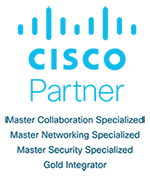Navigating a Hybrid, Modernized Work World
A Four-Part Checklist for Hybrid Work Success
By Joe Latessa, Senior Account Manager at Aspire Technology Partners
For much of the business world, the term hybrid has come to mean more than a car that runs on gas and EV. Instead, it has come to represent the way that the business now works. Employees who formerly spent hours of each day commuting between home and office, now visit their offices only a few times a week – if at all. And those who have returned to the office increasingly interact via video with those who continue to work remotely from home offices and other satellite work locations.
However, many companies today are struggling with how to make “hybrid” work. How can some employees work from a central office while others work from various remote locations while all focused on achieving the same company goals and objectives? How can these companies shake off the paralysis of the pandemic to embrace new modes of communication and collaboration?
Embracing an Agile Workforce Early
The team at one client, a global media company, had a secret advantage: They began to build a hybrid workforce plan before it was a pandemic necessity.
“We had already started moving people towards working remotely, or what our facilities team calls an agile workspace, where users were no longer assigned permanent desks,” says one of the IT directors. “So, the desks that I knew to be my own, where I had my kids’ pictures and everything, was no longer mine. Now I had to share this space. Right before the pandemic comes along, we’re already kind of getting into that mode of working remotely and having users sharing desk space.”
And from so much movement came a sense of how a hybrid and agile workforce could provide the company with the type of competitive, high-performance it needed to navigate the post pandemic world.
Technology Shifts to Mobility & Remote Work
“Traditionally, a good number of us had desktop computers. I loved my desktop, but we moved everyone to laptops, including our contingent or contract workers,” says the IT director.
When the pandemic forced everyone to work remotely, the company’s workforce was able to move quickly since they had already adopted much of the necessary technology and they were now able to work from homes and other remote locations with little more than their laptops, a strong Wi-Fi signal and secure network access.
In addition, the company had been in the process of migrating its desktop and collaboration tools to work both on laptop as well as in small conference rooms, where meetings could be conducted with a worldwide group of employees and contractors, but still feel like a small working group.
Telephony Shifts to Remote Mode as Well
The company IT team also saw an accelerated trend toward using mobile devices and softphones, away from traditional desktop telephony, which has resulted in more cost-effective deployment of telephony.
“At first, when folks went home, at the time I think people loved their desktop phones. Everybody had a desk phone. It was our strategy that any new employee that started with us got a desk phone and a phone number,” says the IT director. But as the company moved to its hybrid model and employees were no longer in the office – preferences began to shift. Employees were using their mobile phones, often via Wi-Fi as a replacement for desktop. There was also a shift in the perception of video.
“We were noticing that more people were using video to take their meetings, and we got away from conference bridges and traditional telephony,” says the IT director. “As people returned, we have been able to take the phones off the desks and move people over to video.” This works perfectly with the company’s agile, hoteling or hot-desking strategy.
A Return to the Office, But Not Office as Usual
Like most companies, the company had attempted to return to the office, only to scuttle its plans due to the pandemic. However, during 2022 the company has been instituting a 3-day office policy to return employees to work on a rotating basis. To prepare for their return, the IT team first made sure that shared equipment – printers, collaboration rooms – were up to date. They worked with the company’s in-house training team to prepare training and materials for returning employees who may have forgotten how to use some of the non-home-based equipment they had at the office.
A Checklist for Hybrid Work Success
The entire experience has offered some perspective to the IT team and the IT director offered a four-part checklist that he recommends for other IT teams to review as they consider hybrid workforces for their own companies:
- Check everything. It may seem like a simple statement, but people forget, “Everything has been off and no one’s been there for two years, so you want to go in and pay attention to detail to make sure that everything is ready for your users.” In this client’s case, it meant ensuring that AV and collaboration rooms were all up and running.
- Be empathetic. As employees, especially new employees hired remotely during the pandemic, now return to the office, make sure that your IT team is empathetic to their technology needs and requests. “They may have forgotten how to do things, so, it’s about making sure that we’re patient. We know we have some hand holding to do to make sure that everybody can do what they need to do when they return.”
- Communicate more. You will not be able to anticipate every user question or concern and that’s where instant communication comes in. “We were caught off guard a little, but we were able to work with our internal training team to craft a new worksheet, or a new cheat sheet, if you will.” The internal communications team would then either print and post these in appropriate places (like near the networked printers) or distribute them via email to the global teams.
- Be flexible. Avoid being rigid in your decisions about technologies and deployment. Keeping an open mind and being flexible is what served the company as it built its hybrid workforce technology stack.
Dealing with Surprise
The IT team found that the biggest surprise was not in leaving the office, it was the speed and the length of time that everyone was at home. An “accelerated hybrid movement” has now become part of the company’s policy – people work from the office on certain days and remotely on other days. Offices are shared spaces. Conference rooms are smaller and more team-focused.
What has not been a surprise is the way that IT teams for network support, desktop engineering, AV and collaboration, have been able to support the global company and its business goals.
Recognizing and understanding the requirements of the organization and aligning these with a strong user experience has been the key to creating an effective and efficient hybrid workspace for all.

Aspire Technology Partners is a Cisco Gold Integrator and Gold Provider engrained in solution pillars that set us apart as a true Cisco solutions provider. We are committed to the continuous improvement of expertise and skillsets around Cisco initiatives that enable us to help and guide customers in the adoption and management of technology architectures designed to transform their organization. We hold Cisco Master Specializations in Collaboration, Enterprise Networking, and Security and are one of only 25 partners in the US to receive the Cisco Advanced Customer Experience Specialization.


